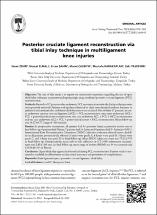| dc.contributor.author | Zehir, Sinan | |
| dc.contributor.author | Elmalı, Nurzat | |
| dc.contributor.author | Şahin, Ercan | |
| dc.contributor.author | Çalbıyık, Murat | |
| dc.contributor.author | Karakaplan, Mustafa | |
| dc.contributor.author | Taşdemir, Zeki | |
| dc.date.accessioned | 2019-02-18T20:10:04Z | |
| dc.date.available | 2019-02-18T20:10:04Z | |
| dc.date.issued | 2015 | |
| dc.identifier.citation | Zehir, S., Elmalı, N., Şahin, E., Çalbıyık, M., Karakaplan, M.U., Taşdemir, Z. (2015). Posterior cruciate ligament reconstruction via tibial inlay technique in multiligament knee injuries. Acta orthopaedica et traumatologica turcica, 49 6, 579-85 . | en_US |
| dc.identifier.issn | 1017-995X | |
| dc.identifier.uri | http://hdl.handle.net/11491/59 | |
| dc.identifier.uri | https://doi.org/10.3944/AOTT.2015.14.0443 | |
| dc.description.abstract | Objective: The aim of this study is to report our institution's experience regarding the use of open tibial inlay technique in patients undergoing single-stage combined posterior cruciate ligament (PCL) reconstruction.Methods: Records of 17 patients who underwent PCL reconstruction with tibial inlay technique were retrospectively reviewed. Patients with ipsilateral femoral or tibial osteochondral avulsion fractures or ipsilateral concomitant tibia and femur shaft fractures were excluded. Out of these 17 patients, six cases underwent anterior cruciate ligament (ACL) + PCL reconstruction, nine cases underwent ACL+ PCL + posterolateral corner reconstruction, one case underwent ACL + PCL + MCL reconstruction and one case underwent ACL+ PCL + posterolateral corner + MCL reconstruction. Mean follow-up was 14.27±6.77 (range: 6-30) months.Results: In preoperative assessments, all patients had 3+ posterior laxity in posterior drawer test; at final follow-up, 6 patients had 0 laxity, 7 patients had 1+ laxity, and 4 patients had 2+ laxity (p<0.001). International Knee Documentation Committee (IKDC) objective evaluation showed severe disability in all patients preoperatively, whereas 5 knees were grade A, 8 knees were grade B, 3 knees were grade C, and 1 knee was grade D at final follow-up. Mean IKDC subjective score was 75.22±7.53 at final follow-up. Postoperatively, mean side-to-side difference in KT-1000 arthrometer measurement was 2.45±1.80 mm. At final follow-up, mean range of motion (ROM) was 0º on extension and 123.56±6.31º on flexion.Conclusion: Open tibial inlay approach is beneficial during PCL reconstruction. Further study is warranted to establish its effectiveness on functional outcomes and prevention of complications. | en_US |
| dc.language.iso | eng | en_US |
| dc.publisher | Scimago Journal Rank | en_US |
| dc.relation.isversionof | 10.3944/AOTT.2015.14.0443 | en_US |
| dc.rights | info:eu-repo/semantics/openAccess | en_US |
| dc.subject | Knee Ligament Injury | en_US |
| dc.subject | Posterior Cruciate Ligament | en_US |
| dc.subject | Tibial Inlay | en_US |
| dc.title | Posterior cruciate ligament reconstruction via tibial inlay technique in multiligament knee injuries | en_US |
| dc.type | article | en_US |
| dc.department | Hitit Üniversitesi, Tıp Fakültesi, Cerrahi Tıp Bilimleri Bölümü | en_US |
| dc.identifier.volume | 49 | en_US |
| dc.identifier.issue | 6 | en_US |
| dc.identifier.startpage | 579 | en_US |
| dc.identifier.endpage | 585 | en_US |
| dc.relation.publicationcategory | Makale - Ulusal Hakemli Dergi - Kurum Öğretim Elemanı | en_US |


















